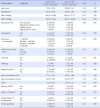|
|
| 1. |
Korean Statistical Information Service [Internet]. Seoul: [cited 2012 December 11].
|
|
| 2. |
Park YH, Suh EE. The risk of malnutrition, depression, and the perceived health status of older adults. Journal of Korean Academy of Nursing 2007;37(6):941–948.
|
|
| 3. |
Korean Ministry of Health and Welfare. The fifth Korea national health and nutrition examination survey V-3(KNHANES V-3). Seoul: 2013.
|
|
| 4. |
Korean Society for Bone and Mineral Research. Physician's guide for diagnosis and treatment of osteoporosis in 2011. Seoul: 2011.
|
|
| 5. |
Koo JO. Association of bone mineral density and blood pressure, calcium intake among adult women in Seoul · Kyunggi area -Based on 2011 KNHANES-. Korean Journal of Community Nutrition 2013;18(3):269–282.
|
|
| 6. |
Park KA, Kim SJ, Park YH, Suh EY, Park MS, Kim ES, et al. A study on the health and nutritional status and nutrient intakes in elderly Korean female. Journal of Korean Biological Nursing Science 2010;12(1):39–47.
|
|
| 7. |
Kim JH, Smi CK, Park YH, Park KA, Suh MH, Lee SO. The effect of the dietary approaches to stop hypertension (DASH) diet education program on bone mineral density in the middle-aged women: a pilot study. Journal of Korean Biological Nursing Science 2010;12(3):195–205.
|
|
| 8. |
Lin PH, Ginty F, Appel LJ, Aickin M, Bohannon A, Garnero P, et al. The DASH diet and sodium reduction improve markers of bone turnover and calcium metabolism in adults. The Journal of Nutrition 2003;133(10):3130–3136.
|
|
| 9. |
Bae YJ, Choi MK, Kim MH, Kim EY, Lee JY, Sung CJ. The relation between net rate of endogenous noncarbonic acid production from diet potassium and protein intakes and bone mineral density in Korean women. Journal of the Korean Society of Food Science and Nutrition 2006;35(9):1200–1206.
|
|
| 10. |
Tang BM, Eslick GD, Nowson C, Smith C, Bensoussan A. Use of calcium or calcium in combination with vitamin D supplementation to prevent fractures and bone loss in people aged 50 years and older: a meta-analysis. Lancet 2007;370(9588):657–666.
|
|
| 11. |
Bonnick SL, Shulman L. Monitoring osteoporosis therapy: bone mineral density, bone turnover marker, or both. The American Journal of Medicine 2006;119 4 Suppl 1:S25–S31.
|
|
| 12. |
The Korean Nutrition Society. Computer aided nutritional analysis program(CAN-Pro) version 3.0. 2007.
|
|
| 13. |
The Korean Nutrition Society. Dietary reference of intakes for Koreans. 1st revision. Seoul: 2010.
|
|
| 14. |
Guigoz Y, Vellas B, Garry PJ. Assessing the nutritional status of the elderly: the mini nutritional assessment as part of the geriatric evaluation. Nutrition Reviews 1996;54(1 Pt 2):S59–S65.
|
|
| 15. |
Leskela H, Risteli J, Niskanen S, Koivunen J, Ivaska K, Lehenkaria P. Osteoblast recruitment from stem cells does not decrease by age at late adulthood. Biochemical and Biophysical Research Communications 2003;311:1008–1013.
|
|
| 16. |
Holick MF. Vitamin D deficiency. New England Journal of Medicine 2007;357:266–281.
|
|
| 17. |
Massey LK, Whiting SJ. Dietary salt, urinary calcium, and bone loss. Journal of bone and mineral research 1996;11(6):731–736.
|
|
| 18. |
Bae YJ, Sung CJ. A comparison between postmenopausal osteoporosis women and normal women of their nutrient intakes and the evaluation of diet quality. Korean Journal of Community Nutrition 2005;10(2):205–215.
|
|
| 19. |
Lee SH. In: Association of bone mineral density with dietary intake and health-related behavior among Korean postmenopausal women. [dissertation]. Seoul: Myong-ji University; 2012.
|
|
| 20. |
Carbone LD, Bush AJ, Barrow KD, Kang AH. The relationship of sodium intake to calcium and sodium excretion and bone mineral density of the hip in postmenopausal African-American and Caucasian women. Journal of Bone and Mineral Metabolism 2003;21(6):415–420.
|
|
| 21. |
Evans CE, Chughtai AY, Blumsohn A, Giles M, Eastell R. The effect of dietary sodium on calcium metabolism in premenopausal and postmenopausal women. European Journal of Clinical Nutrition 1997;51(6):394–399.
|
|
| 22. |
Bolland MJ, Avenell A, Baron JA, Grey A, MacLennan GS, Gamble GD, et al. Effect of calcium supplements on risk of myocardial infarction and cardiovascular events: meta-analysis. British Medical Journal 2010;341:c3691. [doi: 10.1136/bmj.c3691]
|
|
| 23. |
Wang L, Manson JE, Song Y, Sesso HD. Systematic review: vitamin D and calcium supplementation in prevention of cardiovascular events. Annals of Internal Medicine 2010;152(5):315–323.
|
|
| 24. |
Xiao Q, Murphy RA, Houston DK, Harris TB, Chow WH, Park Y. Dietary and supplemental calcium intake and cardiovascular disease mortality: the national institutes of Health-AARP diet and health study. JAMA Internal Medicine 2013;173(8):639–646. [doi: 10.1001/jamainternmed.2013.3283]
|
|




 ePub
ePub Citation
Citation Print
Print






